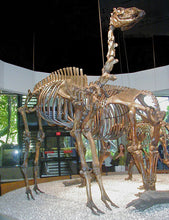
Camelopes hesternus.
Yesterday's Camel skeleton cast replica
Plestocene Rancholabrea CAMELIDAE. Extinct Camel.
LACMNH Page Museum La Brea replica.
DIM. 128in.long skull to tail
24 in.Widest point.
93in. Floor to top of the skull
Item code: AL127
Wood crate required. Freight shipping cost is not included and cannot be calculated in shopping cart. Please call or email for shipping cost.
Camelops is an extinct genus of camels that lived in North and Central America, ranging from Alaska to Honduras, from the middle Pliocene to the end of the Pleistocene. It is more closely related to the Old World dromedary and bactrian and wild bactrian camels than the New World guanaco and vicuña, and alpaca and llama, making it a true camel of the Camelini tribe. Its name is derived from the Ancient Greek κάμηλος (cámēlos, "camel")[3] and ὄψ (óps, "face"),[4] i.e. "camel-face".
Because soft tissues are generally not preserved in the fossil record, it is not certain if Camelops possessed hump(s), like modern camels, or lacked ones, like modern Camelidaes of South America (guanacos and vicunas). One-humped camels are now known to have evolved from two-humped camels, but two-humps, as an evolutionary outcome, likely associated with arctic climates and two-humped camels presumably evolved into one-humped camels in warmer regions in Eurasia,[9] while Camelops first appeared in southern North America and lived among both warmer and colder regions of the continent until early Holocene.
C. hesternus had legs to be 20% longer than that of Dromedary, and was about 2.3 m (7 ft 7 in) tall at the shoulder and weighed about 1,000 kg (2,200 lb).[10








